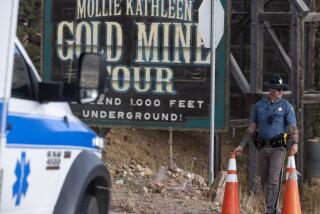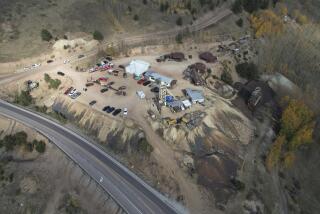Vigil Continues for 8 Men Trapped in Virginia Mine : Blast: Rescue attempts began again after methane samples were taken from a drilled shaft. Family and friends fear being made a spectacle in their grief.
NORTON, Va. â They wait inside Wise County school bus No. 92--wives, mothers, children, brothers and sisters of eight men 1,000 feet down in Southmountain mine No. 3.
Since Monday, when a huge pre-dawn explosion shook the mountain in southwest Virginia, they have sat hour after hour on the hard, straight-backed seats, staring numbly ahead, struggling with increasing difficulty to maintain hope and dignity.
Around them in the December gloom has sprung up an encampment of portable toilets, warming tents and television trucks populated by ministers of the gospel, journalists, neighbors and the merely curious. Almost everyone who came brought food for the waiting relatives--armloads of pizzas, home cooking in Styrofoam coolers, boxed meals.
This is the way it always is when men are trapped in a coal mine.
As darkness fell on the third night, with sleet and snow expected across the mountains, rescue workers were again making their way into the mine. Just before noon, workers finished drilling an eight-inch-diameter shaft into an area near where the miners were working at the time of the blast.
After lowering instruments to sample methane levels in the mine, safety experts concluded that it was safe to resume rescue attempts suspended on Tuesday and shortly thereafter three rescue teams in scuba gear re-entered shafts leading from the portal into the mountain.
Earlier, officials had set off three explosive charges that could be heard in the mine below, as a signal that rescue efforts were under way.
Miners are trained to recognize such surface blasts and bang on the mine floor or on mining equipment around them.
On the surface, rescue teams, armed with sensitive microphones to pick up any signal from below, waited but heard nothing.
These disasters with their prolonged and public suffering have a way of playing with victims such as those on the bus, of grinding down the most courageous. They also have a way of uniting mining towns such as Norton, Va., and bringing together a coal-digging brotherhood.
As the families waited through the day, so did Roy Beverly, who spent 30 years in the mines and now is recovering from lung cancer surgery. So did 79-year-old Ezra Nixon, a miner who helped remove the bodies of 45 friends from a mine at Red Jacket, Va., in 1938, and 92 more from an Island Creek Coal Co. mine in West Virginia in 1940.
But while the scene outside Norton has a brutal sameness and predictability for old men such as Beverly and Nixon, there was nothing repetitious for the people who huddle together on No. 92.
âNothing in the world can prepare you for this,â says Mike Stanley, police chief of nearby Clintwood, Va., who has a cousin in Southmountain No. 3.
Stanley is on the bus, not only to await word of his cousin but to help shore up the rest. He was a miner once. His father died in a mine at Christmas time.
The specter of such tragedies caused him to quit the coal fields and a $40,000-a-year job for a less hazardous career as a small-town policeman starting out at $17,000 a year.
So now he sits on the bus and acts as a buffer for the others, helping keep reporters and photographers at bay, helping steel them for the moment they all fear.
His friends, he says, donât want to be made a spectacle in their grief. Theyâve seen what happens when a mine tragedy brings klieg lights to the coal country.
âThereâs this stigma about us being ignorant hillbilly people,â he tells a photographer, who wants to come aboard No. 92. âThey would prefer that you just stay back hereâ behind the tape.
The sensitivity expressed by Stanley is seldom spoken but it is deep, a feeling of political, social, economic and physical isolation from the more prosperous sections of states such as Virginia, Kentucky, Tennessee and West Virginia--and a feeling of being patronized and put on display when mine tragedy revisits them.
Families on the bus did not say it but friends say they were wounded more than soothed when Gov. L. Douglas Wilder rushed here on Tuesday and spoke with reporters before he ventured over to see them.
Rescue teams had made it nearly 3,000 feet into the mine on Tuesday before being driven back by heat and gas levels that caused fear that another explosion could occur. It was expected to take them several hours to get back to that point Wednesday night. As they began their journey, William Tattersall, chief of the Mine Safety and Health Administration, met with families aboard the bus for the third time during the day.
He found them growing increasingly concerned as the hours passed.
But on the mountain, he said, the rescue teams were still operating on the assumption that âwe are trying to rescue trapped miners.â
More to Read
Sign up for Essential California
The most important California stories and recommendations in your inbox every morning.
You may occasionally receive promotional content from the Los Angeles Times.










